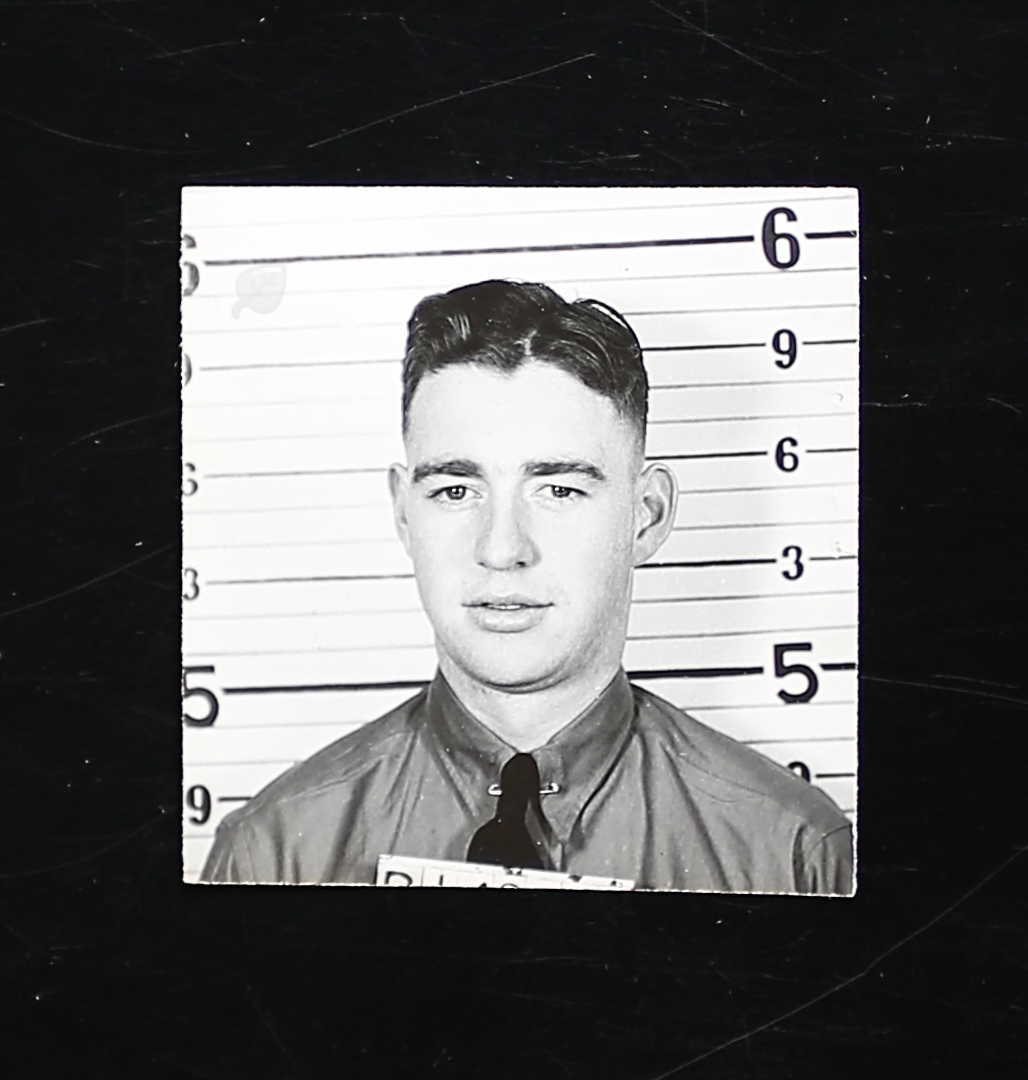
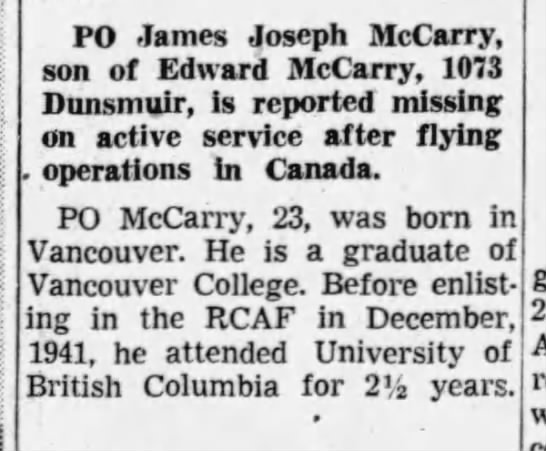

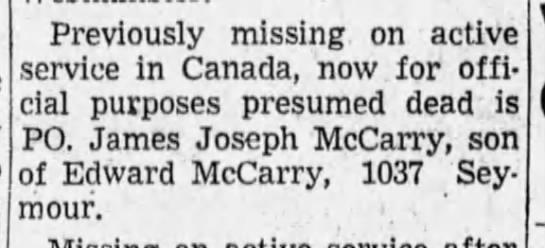

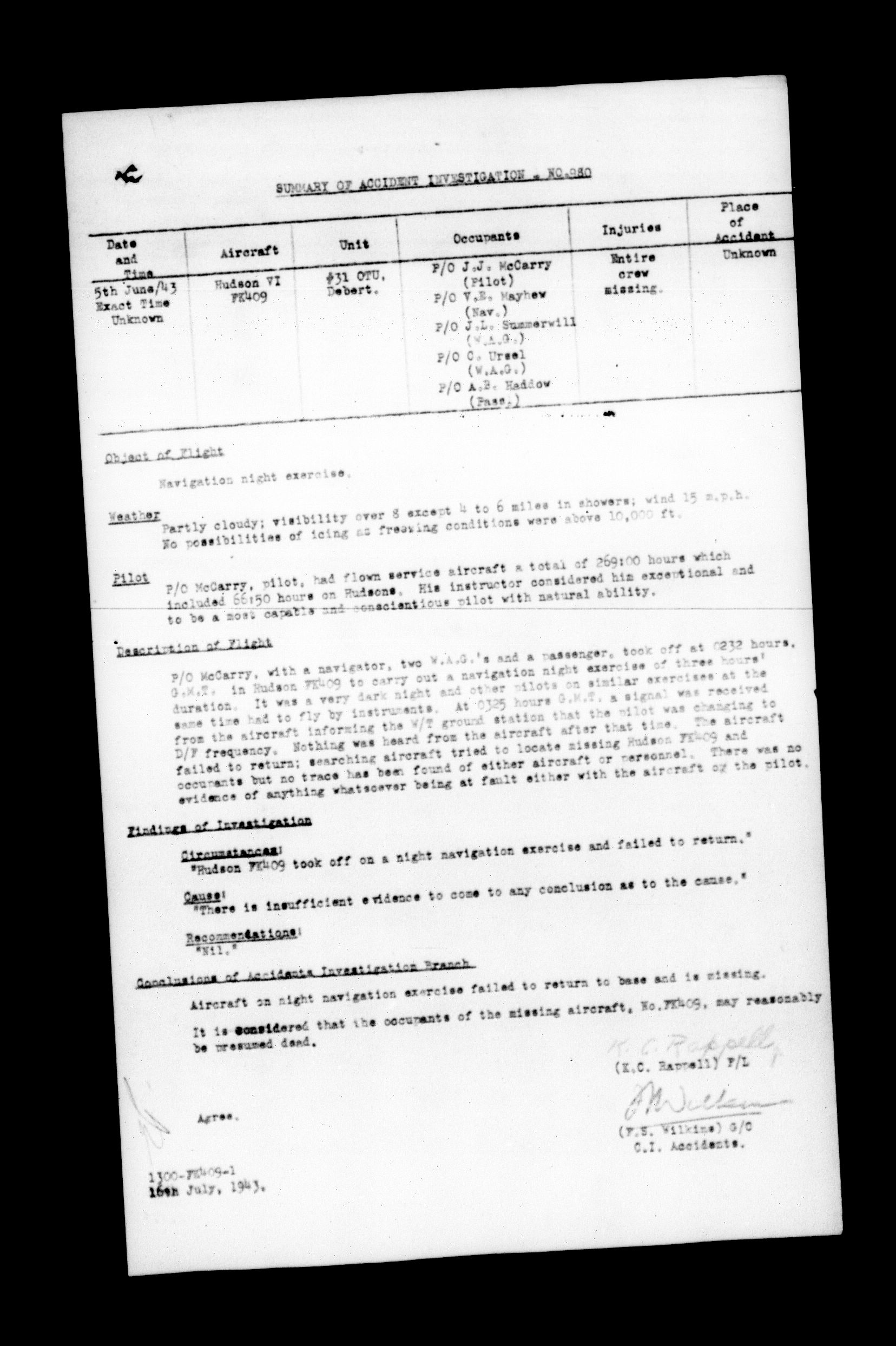
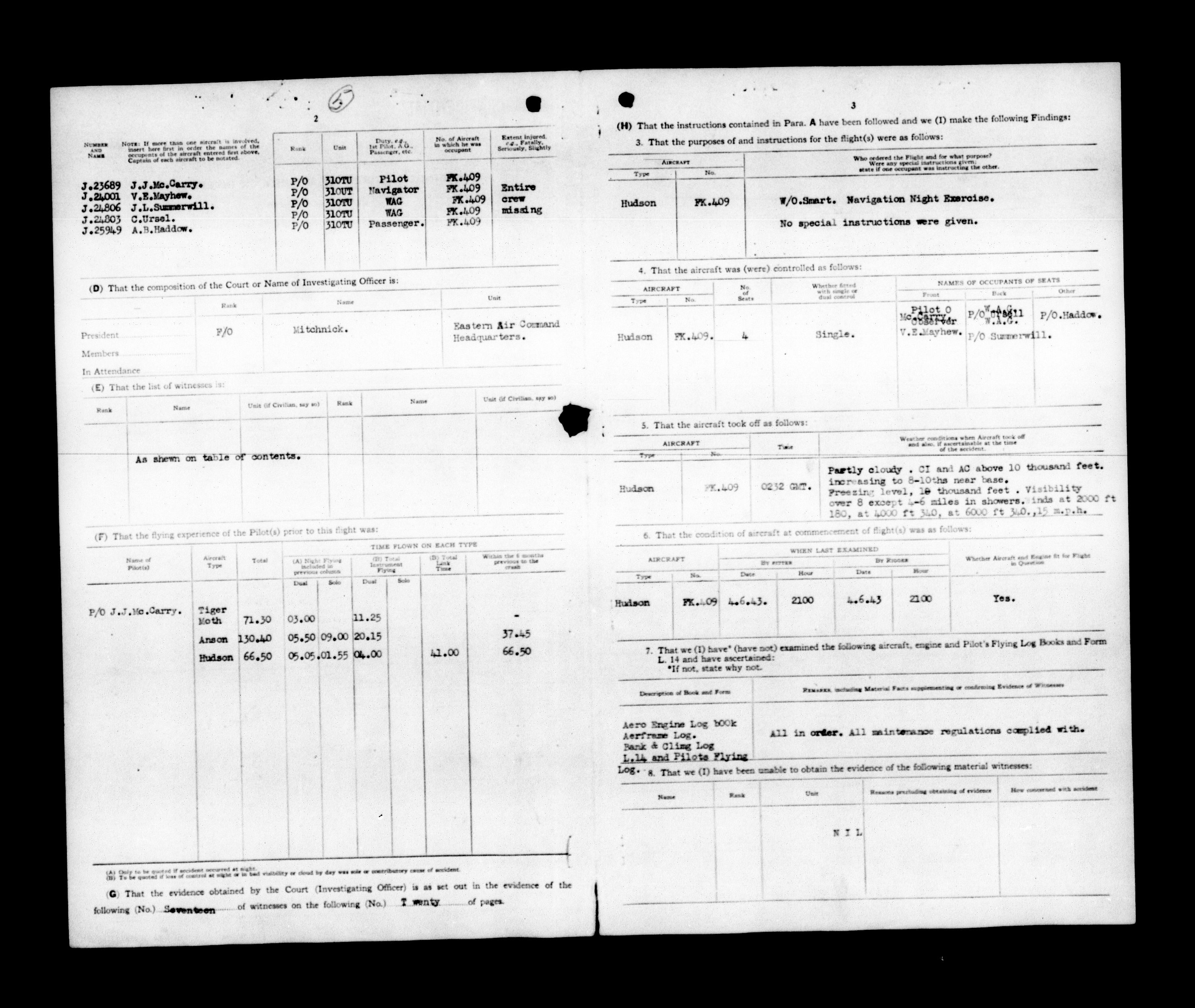
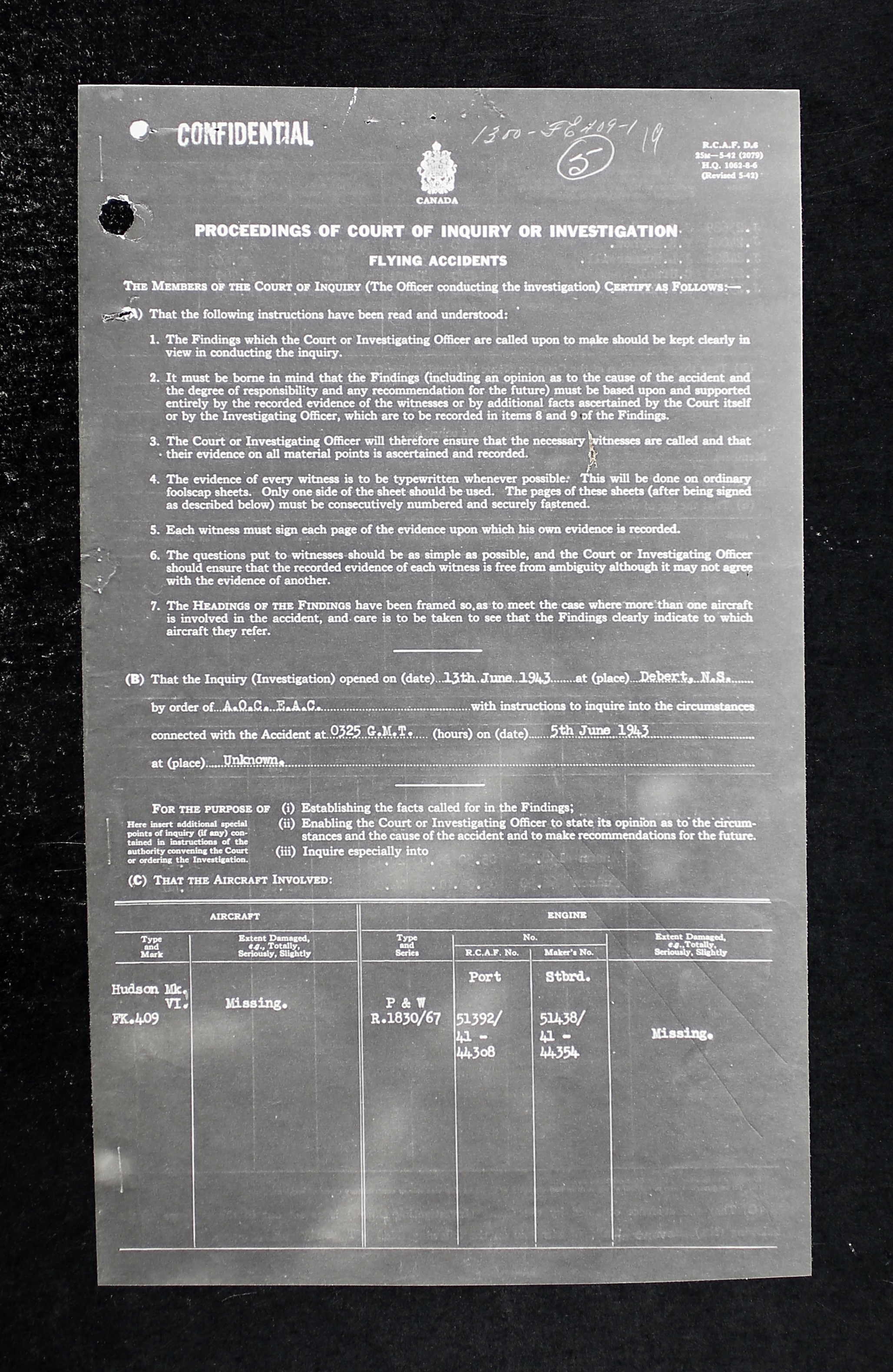
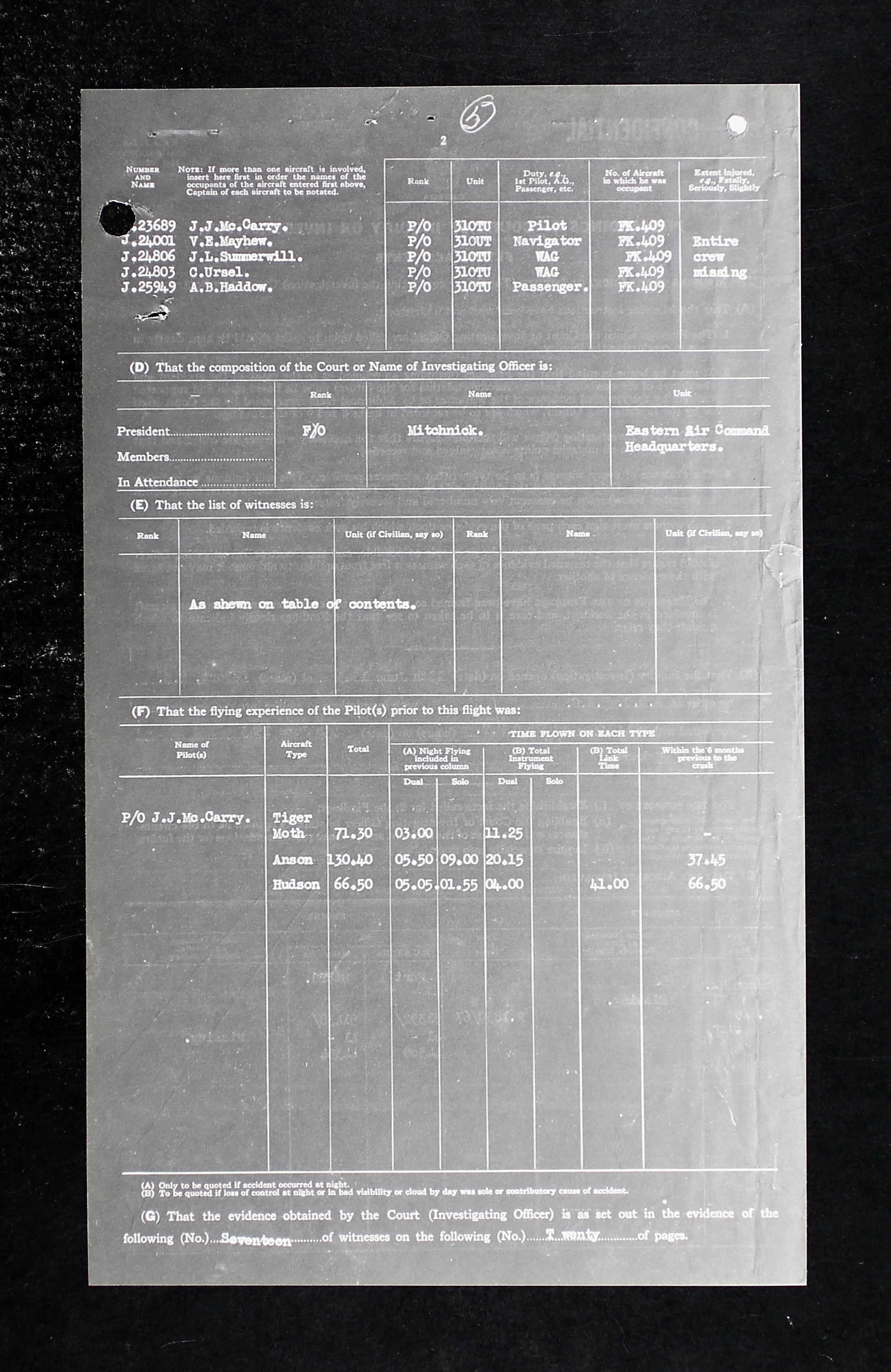
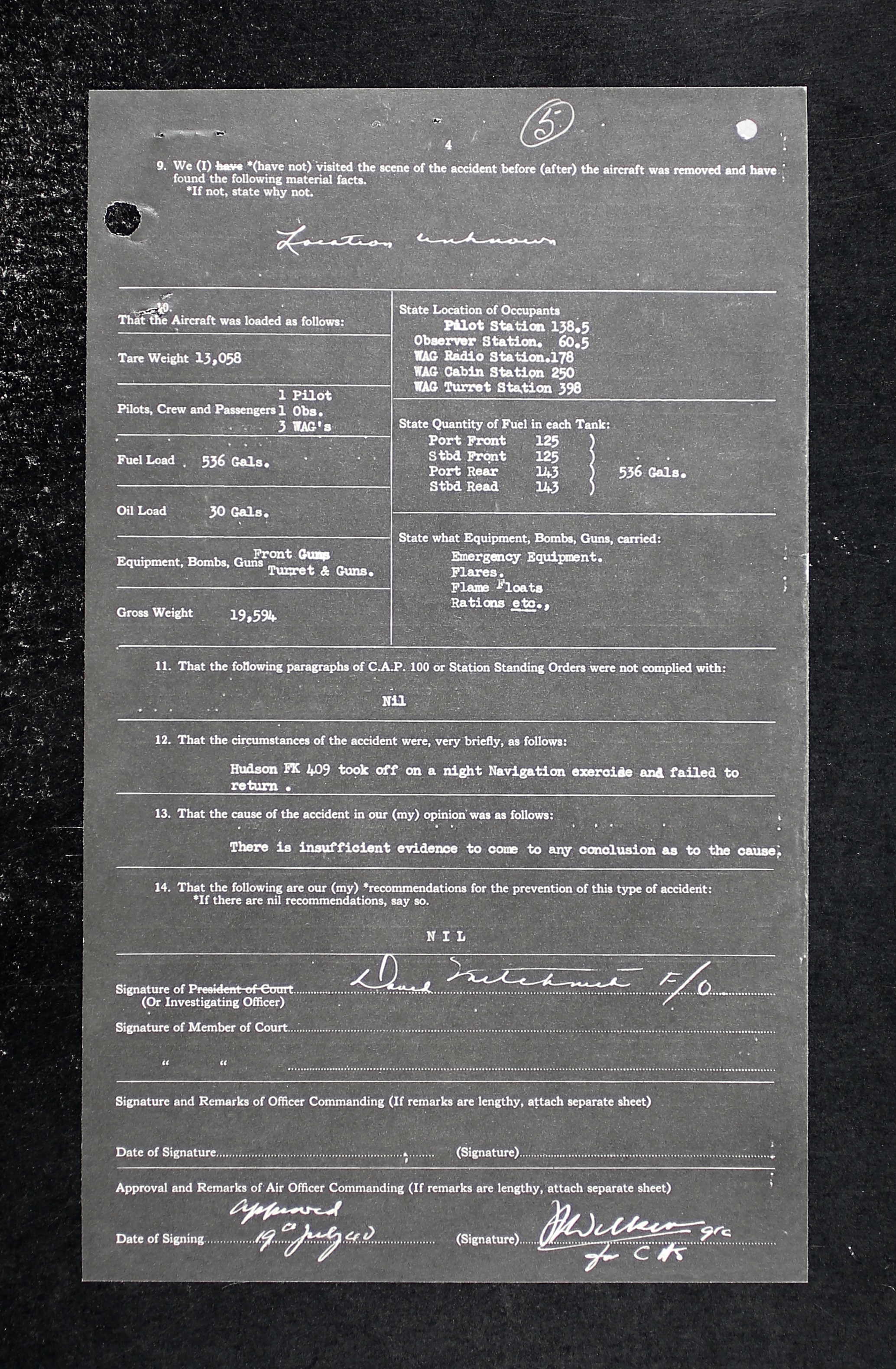
June 6, 1920 - June 5, 1943










James Joseph McCarry was the son of Edward McCarry, CPR freight handler, (1863-1951) and Margaret (nee Kennedy) McCarry (1877-1931) of Vancouver, British Columbia. He had two brothers, Edward ‘Bus’ John McCarry, also enlisting in the RCAF, and Thomas James Patrick McCarry, Portland, Oregon, later of Spokane, Washington, and three sisters, Mary Ann Guichon (1901-1985), Ladner, BC, Winifred Margaret Faulds (1903-1955), Galt, Ontario, later of Vancouver, and Elizabeth ’Betty’ Cecilia McCarry (1906-1983), later a private secretary BC Packers, Vancouver. The family was Roman Catholic.
James trained and worked as a butcher’s apprentice and then worked as a bus driver for four months for BC Electric for five years prior to his enlistment with the RCAF in December 1941. He also worked as a salesman for Coca-Cola while he was a student at UBC. He had a Grade XII education and had attended UBC for two years studying sciences and commerce. After the war, he wanted to get into sales. “Wiry.” He stood 5’10 ½” tall, weighing 151 pounds in October 1941. He had blue eyes and brown hair, with a fair complexion. By May 1942, he put on ten pounds. He had a scar from a dog bite on his right wrist. He had ‘excellent’ teeth. “Good physique. Better than average intelligence. Alert young lad. Always did well at school. Energetic dynamic personality. Motives that of wanting to fly and fear of Japs reaching BC. Pretty emotionally and seemingly mature. Extrovert type and impresses as the right kind for pilot. Possesses leader’s ability Night vision: high average.” James indicated he had one year of varsity French. He was selected as the All-Star quarterback in the Vancouver Junior City League, 1939. He also liked baseball, basketball, and English rugby. He smoked ten cigarettes daily and drank socially.
He had 13x$5 War Savings Certificates and a $1000 life insurance policy, beneficiary to Betty, his sister.
James was at No. 6 ITS, Toronto, May 11 to July 3, 1942. He was 24th out of 68 in his class with 85.5%. “Keen alert type with excellent spirit. Has plenty of ability and a very determined nature. Second aircrew recommendation: Air Observer.”
He was then at No. 12 EFTS, Goderich, Ontario, August 3 to September 25, 1942 and was 8th out of 33 in his class with 83%. “An above average student who is clean cut and shows plenty of ability. Easy to get along with and well liked in class. Flying is a high average. Link mark: 75%.”
At No. 9 SFTS, Centralia, Ontario, from September 28, 1942 to February 9, 1943, he was 15th in his class out of 59 with 80.8%. He earned his pilot’s wings. “Very high average pilot. Confident, steady, smooth, and capable.”
At Nav. Reconn. Course, Summerside, PEI, February 15, 1943 to April 16, 1943, he was assessed as above average and was 10th in his class with 75%.
He was taken on strength at No. 31 O.T.U., Debert, Nova Scotia on April 16, 1943.
On June 5, 1943, the crew aboard Hudson FK409 failed to return from a night navigational exercise near Debert, Nova Scotia. They were P/O Alexander Broom Haddow, J25949, WAG, Pilot Officer Vernon Earle Mayhew, J24001, Navigator, Pilot Officer James Joseph McCarry, J23689, Pilot, Pilot Officer John Leslie Summerwill, J24806, Navigator, and Pilot Officer Clifford Bernard Ursel, J24803, WAG. [Hudson FK409, microfiche C5937, Image 3876, 3935]
He had 66.50 hours experience flying Hudson aircraft and 41 hours total Link time.
The weather was partly cloudy. “CI and AC above 10,000 feet. Increasing to 8/10th near base. Freezing level 10,000 feet. Visibility over 8, except 4-6 miles in showers. Winds at 2000 feet 180, at 4000 feet, 340, at 6000 feet, 340, 15 mph.” According to the fourth witness, Graeme Cameron, Met Officer, “There were no possibilities of icing that night as freezing conditions were above 10,000 feet and visibility was over 8 miles.”
The plane was fully fueled and mechanically and structurally sound. Seventeen witnesses were called at the Court of Inquiry.
The first witness was S/L D. M. Brown, RAFVR, 72067, Senior Medical Officer at 31 O.T.U., Debert, Nova Scotia. “I have checked the medical documents of P/O J. J. McCarry and I find that he was in excellent physical condition. He has had no illnesses requiring his admission to hospital since his entry into the service. In company with the remainder of his service, he was seen by me the day he joined the unit. From this and observations that I have made of him during classes, and in the Officers’ Mess, I can think of no abnormal physical condition which might have affected his flying. Fatigue would not be entered into the disappearance of his aircraft.”
The third witness, F/O A. G. MacKinnon, J15282, Controller of Operations Room stated that “the duration of the trip being 1 ½ hours. The crew were briefed to carry out a Navigation Exercise as detailed on the programme of the night June 4/5, 1943. Over and above this, the crew were instructed to keep in contact with base every half hour after their W/T Go together with their position messages on the major alterations of course. The crew was briefed at 0140 hours June 5, 1943. The aircraft obtained its W/T Go at 0230 hours. The next contact with base was a 0325 when they requested permission to change frequency from 3030 Kcs to 5540 Kcs and were not heard from again. At 0525, I requested an R.D. F. Plot from Eastern Air Command who informed us that the Air Detection Corps had reported an aircraft in the vicinity of Sherbrooke at 0515. At 0530, the Filter Room in Eastern Air Command informed us that an R. D. F. Plot was found of an aircraft proceeding out on the first leg of the detailed Navigation Exercise and returning to approximate 15 miles south of Halifax where the plot faded, the time of plot: 0348. All the necessary details were passed on to EAC concerning the route of the exercise detailed, the time airborne, expected time of arrival at base, last contact with aircraft, and radio frequencies used for overdue action to be taken, at 0600 hours. At 0612, requested the officer in charge of Night Flying to turn on rotating beacon. At 0615, instructed all crews proceeding on Anti-Submarine Patrol to break W/T silence if any transmission from 409 was heard and to immediately inform base. at 0620, requested the Met Officer to originate a message QAWA in reference to Hudson 409. At 0630, Command Flying Control informed me that listening watches were set up in Sydney, Yarmouth, Dartmouth, and Halifax. At 0633, requested DFD to have rotating beacon turned on at Pennfield Ridge, Moncton, Charlottetown, Greenwood, Dartmouth, and Yarmouth. At 0640, informed the Acting CI. At 0653, CFC reported an RDF Plot of an aircraft proceeding from Greenwood towards Digby. Requested CFD to have Greenwood and Yarmouth call Hudson 409 on its RT Frequency. It should be pointed out that this one continuous RDF Plot was an unidentified aircraft and was possibly Hudson 409 as no other aircraft from EAC were flying at the time. However, it subsequently proved to be an American aircraft which neither EAC nor Debert knew anything about. At 0707, DVD gave us the plot of an aircraft at Digby. At 0709, originated a message to 409 giving its position as Digby at 0707. At 0726 CFC reported a plot of an aircraft…at 0735, requested CFC to contact Yarmouth and Pennfield Ridge to broadcast the latest RDF Plot as these stations are considerably closer to the plot than Debert is.” He continued, “It might also be added that during the briefing, the crews were warned that if they should fly over any village or town that they were unable to identify, they were to circle this particular spot and fire of cartridges at regular intervals so that the ADC could report their position. They were also instructed to make the utmost use of the marine lights available for fixing their position.”
The seventh witness, P/O W. McDonald, RAAF 4505, stated, “The stars were visible but conditions were hazy over the sea with no moon. I have flown with P/O McCarry on quite a few occasions and considered that he was an excellent pilot. This is further evidenced by the fact that while flying as second pilot with P/O McCarry, he brought the aircraft back to base on one engine successfully. I can give no opinion as to the cause of the accident.”
The eighth witness, Sgt. G. McFarlane, 130919, stated, “Flying conditions were quite good but due to the darkness of the night, we were required to fly the whole trip on instruments. I have flown with P/O McCarry on a number of occasions and consider him a capable and reliable pilot.” He, too, could not come up with a cause of the disappearance of Hudson FK409.
The ninth witness, F/L A. W. R. Perry, 40845, stated that McCarry was “a well above average pupil and pilot.” Perry had flown Hudson FK409 about a week prior on a test flight and found the aircraft to be “nose heavy on landing, requiring 25 degrees of elevator trim. This fact was reported by me. S/L Hunn also flew this aircraft and confirmed by observation. The aircraft was sent over to Maintenance Section for check and on return to the Squadron was found to be normal in trim. Since that time, to the best of my knowledge, no one has reported a similar behaviour.”
The tenth witness, Sgt. W. M. McBean, R115664, stated that he was student pilot. “I have flown with P/O McCarry both during the day and night. He appeared to be a capable pilot and all times exercised caution.”
The eleventh witness, Sgt. C. E. Johnson, RAAF 420954, student pilot, stated, “I have flown with P/O McCarry both during the day and night and have formed the opinion that he is a very capable and confident pilot.”
The twelfth witness, S/L W. G. Tiley, 45766, signals officer stated, “The reason P/O McCarry changed to DF is because for the purpose of training crew, they are instructed to use DF Bearings on all flights and as in this instance, no priority was given to the message and there was no indication that the aircraft was in trouble, it is considered that this change to DF was a routine matter. The ability of the crew: as far as the WAGs are concerned, P/O Ursel was assessed at well above average. He had carried out four navigation exercises previous to this flight and his total flying time at this unit as WAG was approximately 19 hours. The other WAG, P/O Summerwill was assessed as slightly above average. He had also carried out four navigation exercises previous to this flight. His total flying time whilst under instruction at this unit was approximately 16 hours. P/O Haddow had been under instruction less than 7 days at this unit and no assessment can be given. He was carried in the aircraft as a passenger only.”
The fourteenth witness, W/O J. M. Stewart, 748101, duty instructor stated that P/O Haddow was authorized to go on this trip as look-out for training in night vision.
The thirteenth witness, F/L J. M. M. Rabone, 90226, Flying Instructor, stated that he was P/O McCarry’s instructor for three flights. (5 hours, 20 minutes, dual instruction including 2 hours 10 minutes night flying). On P/O McCarry’s transfer to No. 2 Squadron, I noted in my report dated 17.5.43 ‘This pupil started with F/L Boyle. The best pupil pilot I have flown with on this Unit. By the standard at 31 O.T.U., he is in my opinion, exceptional.’ I considered P/O McCarry to be a most capable, conscientious and reliable pilot with natural ability. His previous training had been on Cessnas and he never appeared to have any difficulties during his conversions training on Hudsons. While P/O McCarry was, as I have indicated above, a very able pilot, he never appeared over-confident and I would not agree that the disappearance of the aircraft could be attributed to any incompetence or inexperience on the part of P/O McCarry.”
The cause of the flight’s disappearance was considered to be obscure.